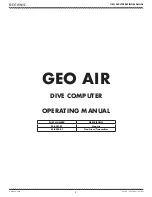
21
73VR2102 / 73VR2104 / 73VR2106 / 73VR2108 / 73VR2110 / 73VR2112 USERS MANUAL EM-7395-B Rev.24
3. HARDWARE CONFIGURATIONS
Burnout, Cold junction compensation, Line noise filter and A/D conversion mode are selectable. Analog inputs’ update
cycle is determined by the line noise filter and the A/D conversion mode..
Burnout for T/C and RTD input
Upscale, Downscale or No burnout selectable. Select ‘No Burnout’ to minimize the measuring errors caused by the
sensor/wire resistance and the burnout sensing current.
>>> Refer to Section “5.5.1 PEN SETTING (INPUT)”.
Cold junction compensation (CJC) for T/C input
CJC can be enabled or disabled per each channel.
>>> Refer to Section “5.5.1 PEN SETTING (INPUT)”.
Line noise filter
NMNR ratio to the line frequency and its harmonic contents can be optimized. Select either frequency for the most
effective result.
>>> Refer to Section “5.6 HARDWARE CONFIGURATION”.
A/D conversion mode
Fast, Medium or Slow selectable for all channels.
With Slow setting, data fluctuations are minimized with limited sampling time (speed). With Fast setting, sampling time
(speed) can be high through data fluctuations increase.
>>> Refer to Section “5.6 HARDWARE CONFIGURATION”.
n
ANALOG INPUTS’ UPDATE CYCLE
LINE NOISE FILTER FREQ.
A/D CONVERSION (sec.)
MEDIUM
*
1
SLOW
FAST
100 ms RATE
50 Hz
0.39
0.54
0.27
0.095
50/60 Hz
0.37
0.50
0.25
60 Hz
0.34
0.46
0.23
Multiplied by two (2) for RTD and potentiometer input.
*
1. Standard setting
















































